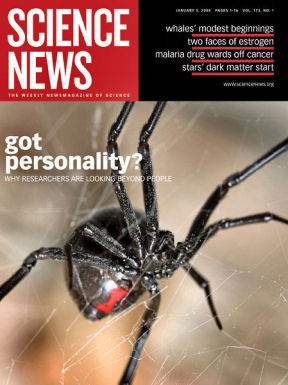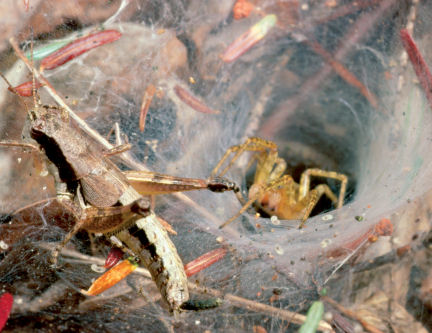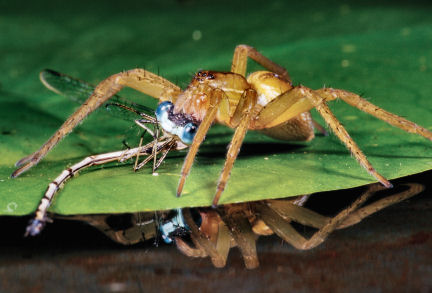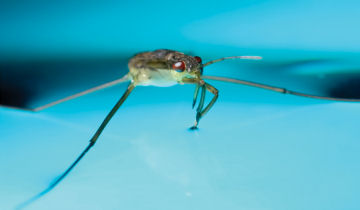Chad Johnson wants to know what’s up with all the black widow spiders. So do plenty of other people who’ve moved to Phoenix, or managed to be born there, in such numbers that it has become the fifth-most-populous city in the United States. Phoenix residents wonder why the population boom hasn’t been limited to people. There, as in some other sunbelt cities, black widows have become the new cockroaches.




In the desert surrounding Phoenix, members of the same black widow species lead relatively solitary lives, in contrast to urban congestion among downtown spiders. So scientists like Johnson, at Arizona State University West in Glendale, ask why a supposedly cranky loner of a species has taken so enthusiastically to city life. Perhaps, he conjectures, the urbanization of the black widow has something to do with personality.
Yes, he’s talking about the personalities of the spiders.
He and other researchers are looking beyond the general traits of a whole species to see what diverse patterns of behavior emerge within that species. It’s too early to tell yet, but perhaps a portion of the former desert-dwelling black widows have quirks that let them thrive around bright lights and big cities.
So biologists are looking for personalities, or “behavioral syndromes,” in a lot of strange creatures: spiders, dumpling squid, even crickets and water striders. From the beginning, the spineless set has starred in the new wave of exploring such personality possibilities.
The question isn’t just whether the creatures have personalities. It’s also about what difference the personalities make. In some species, suites of behaviors turn up in different situations. They can create interplay across situations, harmoniously or disastrously. A particularly macho spider might catch a lot of prey and grow fat and flossy, but then fail to prevail in courtship rituals that demand more finesse. Personalities might illuminate trade-offs in evolution of traits and might even explain some otherwise mighty peculiar animal behavior.
Real characters
To build up gently to this idea of personality for spiders, think of variety. Think of aggression.
It’s a part of life for funnel spiders (Agelenopsis aperta), says Ann Hedrick of the University of California, Davis. They construct sheets of silk, a hand’s breadth of white mist hovering over the ground or along a plant scaffold. In the center of the sheet, a slightly tapering silk funnel drops like a fat heating pipe to a safe haven under a rock or in a tuft of grass. Should one funnel spider walk on to another’s web, the current owner dashes out of its tunnel to clarify who’s home and who had better scuttle away.
Some funnel spiders prove more aggressive than others, and similar differences hold true for populations, says Hedrick. She and Susan Riechert of the University of Tennessee in Knoxville compared aggression in spider groups from two states. The researchers paired opponents of equal size for duels, measured territory size, and clocked spiders rushing at prey.
Why does any animal have a behavioral syndrome? Why do humans have a personality?
– Andrew Sih, University of California, Davis
That evidence provides a first step for demonstrating personality-predictable variation between two groups of individuals of the same species. Hedrick and Riechert went on to test for something more interesting, links between aggression and other tendencies.
Spiders differed in how cautious they were around predators. The web sheet doesn’t have goo to snare an insect that lands on it, so hungry spiders lurk in the mouths of their funnel, ready to shoot out when prey arrives. The tunnel mouth makes a great position for hunting but leaves the spiders partly exposed to birds, mice, and other animals that, in turn, are hunting them.
Hedrick and Riechert mimicked the rush of air and web vibrations of an incoming bird by puffing at the spiders with a squeezable bulb designed to blow dust off camera parts. The New Mexican spiders proved less fearful. When puffed at, these spiders did dive into their tunnels for shelter. Yet the New Mexicans didn’t take as long as the Arizonians to tiptoe back out to their hunting spots.
So the New Mexican’s kick-carapace fighting approach might share a link to another trait, a tendency to get over a scare quickly. To explore that possibility, the researchers narrowed their study to the level of individual spiders. In another tournament of spider fights, the individuals that proved feistier were the same ones that had recovered faster from the scary camera puffer. The two behaviors, exhibited in different circumstances, did seem to share a link.
When spiders from the two populations had offspring in the lab, the youngsters still differed despite growing up in the same environment. The researchers concluded that each of the behavioral traits had a genetic basis. Hedrick speculates there’s a strong possibility that testing individuals within populations would reveal a genetic link between behaviors.
You say syndrome
Debating just what to call such linked behavioral tendencies—personality? behavioral profile?—can start a bar fight in some quarters.
Andrew Sih of the University of California, Davis, has been arguing (nonviolently) for behavioral syndrome. In 2004, he, Johnson, and Alison Bell, now at the University of Illinois, Urbana–Champaign, published an overview defining “behavioral syndrome” as “suites of correlated behaviors across situations.” In 2006, Sih led a symposium on behavioral syndromes at the Animal Behavior Society’s annual meeting.
That definition leaves plenty of interpretive wiggle room. But Hedrick sees the funnel spiders as a clear example of correlation: The spiders genetically predisposed to thrash rivals in a fight tended to return to business fast after an upset.
So she’s able to address the question of how that link might affect evolution. A trait favorable in one situation may be a hindrance in another. The two lineages of spiders came from habitats with very different pressures, and in their case, the link between the behaviors was to their benefit.
The Arizonian’s riverbanks buffer the extremes of temperature and provide plenty of insect prey. Birds, however, also feast on the riparian abundance. When feeding chicks in nesting season, birds along the river killed a weekly average of 40 percent of the funnel spiders in test plots, Hedrick says.
In contrast, the New Mexicans have a tough time finding food in their sparse grassland. Dependent on their environment for regulating body temperature, they work their webs only during the few hours when the nightly chill has eased and before the day has turned scorching hot. At least the slim pickings out there mean predatory birds are relatively rare too.
Facing such scarcity, it’s no wonder the New Mexicans have turned scrappier. They compete more fiercely among themselves for food than the Arizonians do, says Hedrick. Because some common underpinning unites the two traits, that heightened aggression also favored the tendency to return to normal quickly after a close call from a bird attack.
On the relatively plush riverbanks of Arizona, though, relentless predation could be pushing the spiders toward caution and longer hiding times in their funnels. In turn, this fearfulness carries with it the milder manners.
Since the spider work, Hedrick has found another set of linked behavioral traits, this time in field crickets (Gryllus integer). One of the traits is male sex appeal. The males trill to display their charms, and some trill longer than others. For winning the attentions of a female cricket, longer is better. Hedrick has found that the length of the male trill is heritable. When she tests crickets for their reactions to predators, “males with more extravagant displays are more cautious,” she says.
Hedrick is now working on a possible new twist. She has staged rounds of cricket battles and discovered that caution around predators tends to go with losing fights. So she is testing her chain of connections to see if males with hot trills get whupped. If so, the usual pattern of animal mate choice upends itself, as females pick up males from the floor of the fight club.
Odd couple
Such counterintuitive combos of traits illustrate one of the beauties of the idea of behavioral syndromes, says Johnson. An animal’s behavioral syndrome can foster beneficial action in one situation but screwy, even maladaptive, acts in another. So finding a syndrome could explain some otherwise baffling traits.
The fishing spider (Dolomedes triton), which Johnson and Sih study, raises a question, all right. The most ferocious females in a population sometimes eat their suitors. Sexual cannibalism isn’t all that rare among spiders, but the most extreme among the fishing spiders kill before they can mate.
Those females do lay eggs, but unfertilized, so the eggs don’t develop. Considered as an isolated phenomenon, there is no way that premature mate murder makes sense.
In the 1990s, evolutionary biologist Göran Arnqvist of the University of Uppsala in Sweden suggested looking at more than one behavioral trait at a time to see whether mate killing represents a spillover of some other trait. Outsized aggression, for example, could bring rewards as the juvenile females scrabble for food. A dead suitor later in life would amount to a side effect of the teenage appetite.
Johnson and Sih have been studying that as a scenario for a behavioral syndrome. Overall, their results support the spillover/syndrome concept, he says. For example, juvenile females grew larger when they fed on abundant food, and that size bonus led to a spiderling bonus. The most recent paper, in the November 2007 Animal Behaviour, explores whether the proposed syndrome of boldness extends to a spider’s parental care (no), speed of recovery from alarm (yes, for adult spiders), and zest for hunting (also yes for adults).
In another case of a behavioral syndrome with mixed blessings, extra zest for a fight turns ugly when water striders go courting.
The long-legged species Aquarius remigis skates over pond and stream surfaces right into odes to the tranquillity of nature. In the real world, though, water striders lead contentious lives. Males fight each other readily and don’t wait for invitations to zoom over the water pursuing females.
For an unusual look at the consequences of all this machismo, Sih and U.C. Davis colleague Jason Watters sorted male water striders into a number of groups. One group included only the most aggressive and active males; the other groups had fewer and fewer of the rambunctious types. The last strider club included only males with relatively mild ways.
When the groups mingled with females, the go-getters didn’t fare so well. They dashed around with unusual energy, but females shied away from them and even fled the group. In tallying the matings in each group, the researchers could track the effect of extra-aggressive males. Their abrasive manners dragged down the mating success of milder males in the same group.
The whole idea of these mismatched consequences for traits unsettles Bryan Neff of the University of Western Ontario in London (Canada). “I don’t challenge that behavioral syndromes can exist in nature,” he says. It’s their prevalence and utility he’s waiting to see. Evolutionary forces should routinely render the syndrome irrelevant by lightening its dark side, he argues. If a gene makes an animal a bold hunter but a lousy lover, then Neff predicts a modifier gene will eventually arise and mute the boldness when it gets in the way.
Sih likewise muses about how much remains unknown. He says he’s looking for a framework that could predict why behaviors sometimes end up correlated and sometimes not. If he can figure out that, he could tackle some other big questions. “Why does any animal have a behavioral syndrome?” he says. “Why do humans have a personality?”





